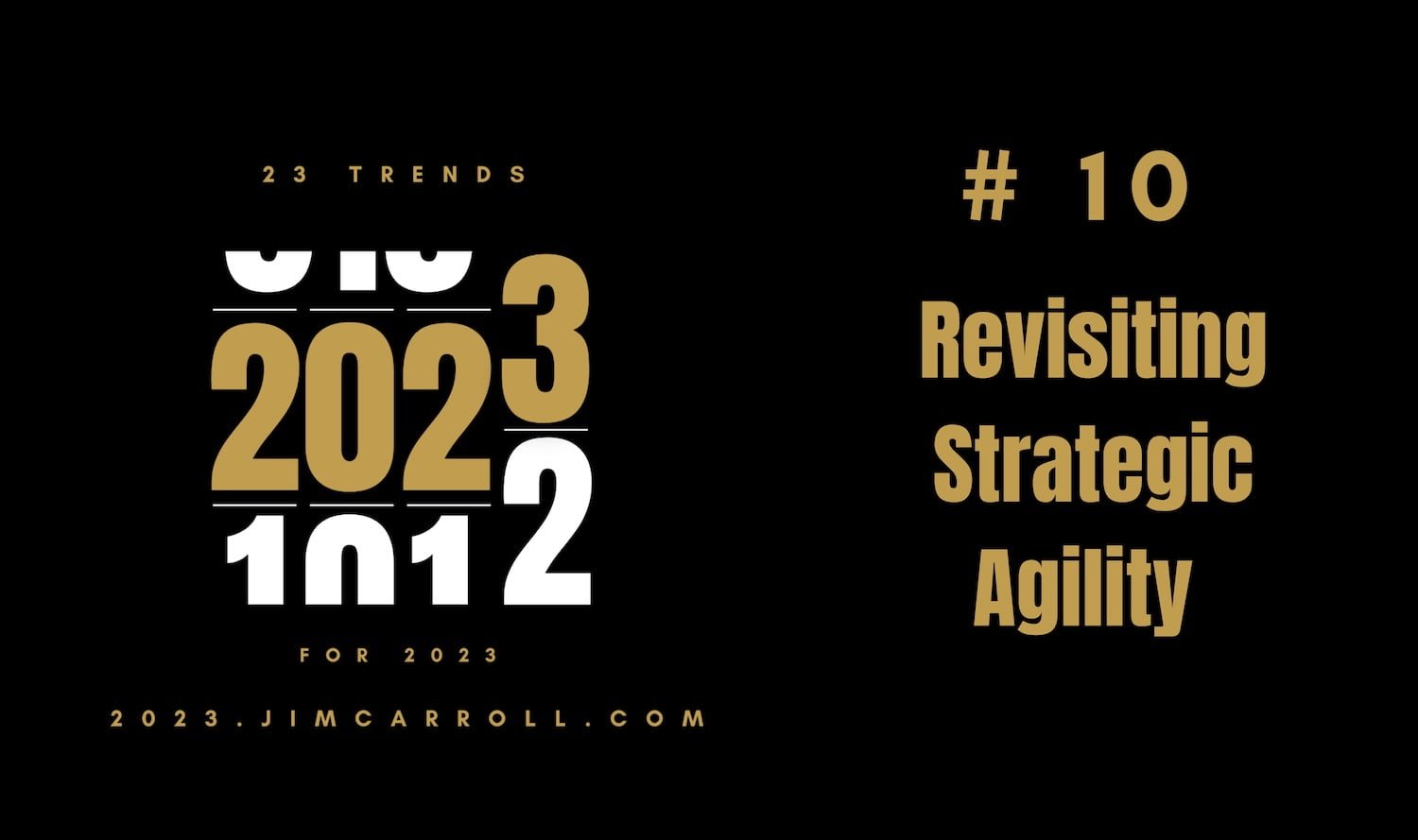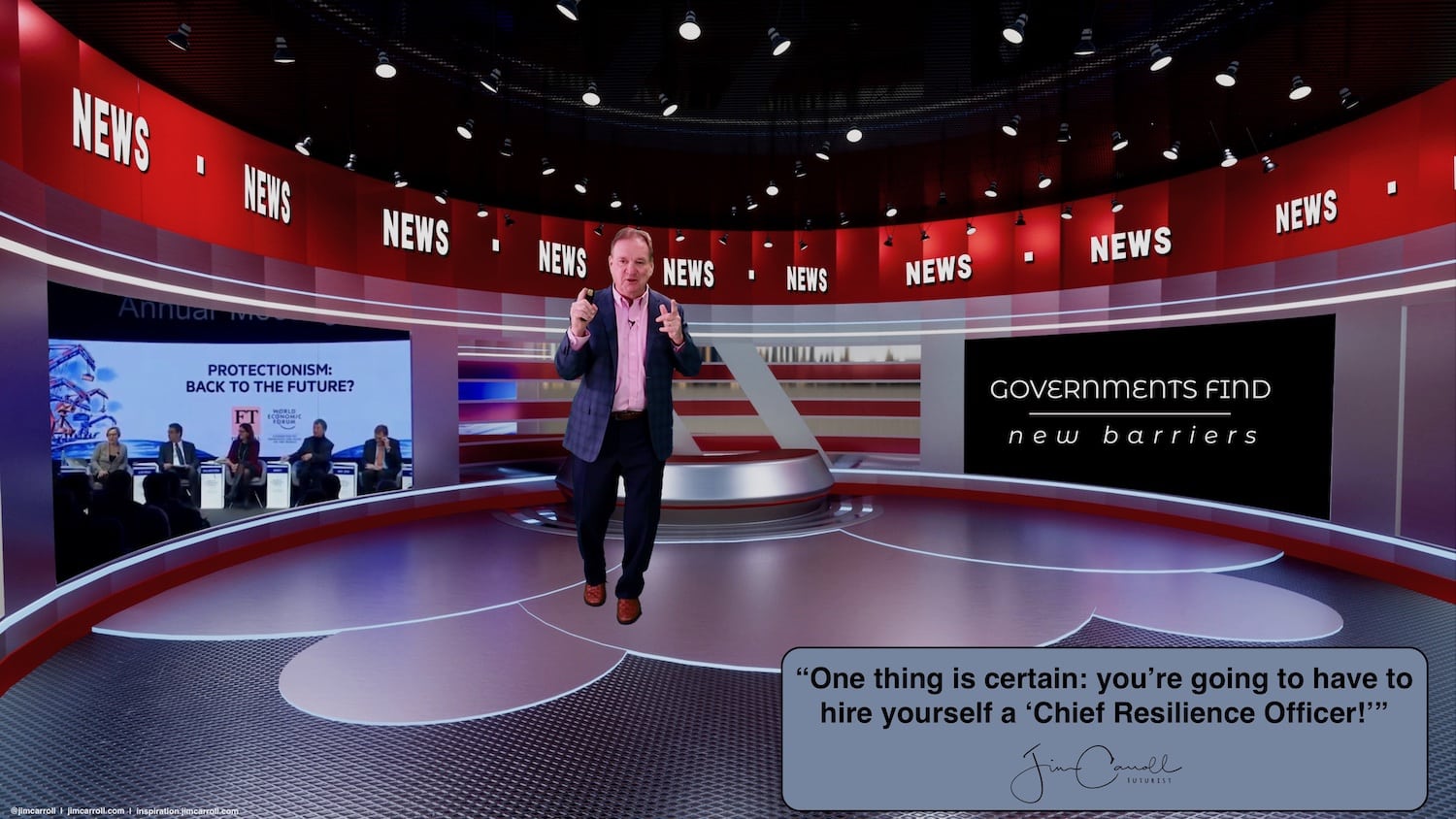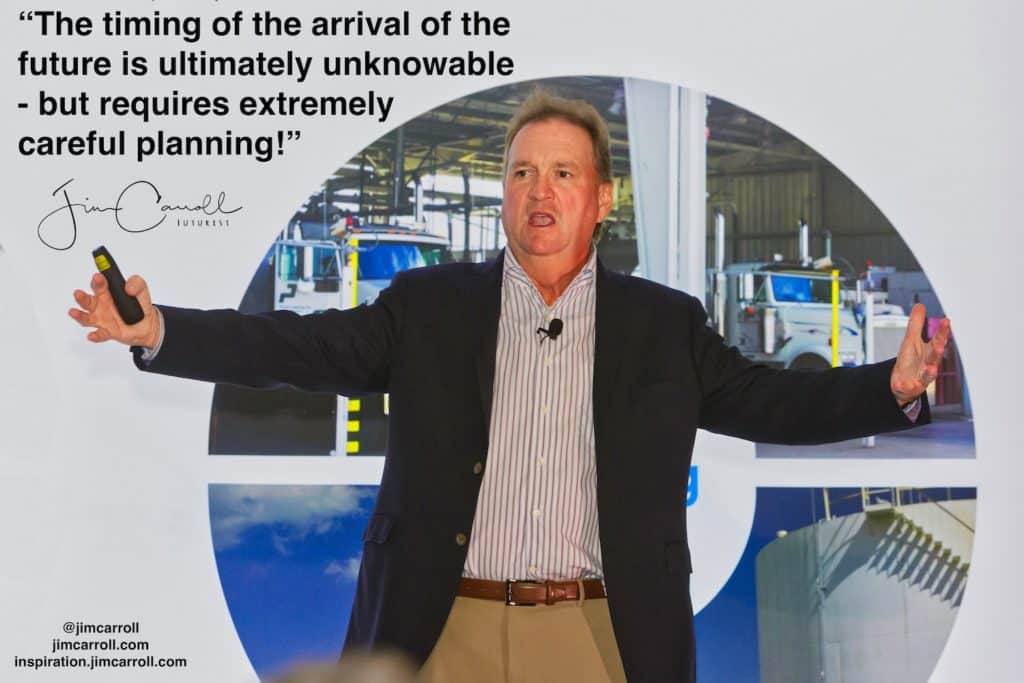We need to plan faster with bigger goals in mind – but we’ve been distracted.
After all, we’ve been in triage mode with our organization in dealing with the pandemic, supply chain challenges, a volatile economy, and workforce issues.
That’s why trend #10 of my “23 Trends for 2023” has to do with the idea of ‘revisiting strategic agility’ – which is to say, the ability to plan faster with bigger goals in mind!

What is Strategic Agility?
Over at the SpriggHR site, they define ‘strategic agility’ this way:
In a fast-paced business world, being able to adapt to sudden changes in market conditions or customer needs is as important as ever. Regardless of the source of a business disruption, the ability to respond quickly and rework your organization to suit the new environment is a valuable asset for any modern business today. This asset is referred to as strategic agility.
Agility demands that we able to shift mindsets and actions rapidly according to fast-moving circumstances.
Leadership agility—or the agility to shift and pivot mindsets—is the master competency needed for sustained success in our fast-paced and complex business environment. In practice, leadership agility is what gives leaders the ability to lead effectively when rapid change and uncertainty are the norm and when success requires consideration of multiple views and priorities.
Building Leadership Agility in Today’s Complex World, 13 December 2021
Fulton County Daily Report
Add to that several key issues that I constantly reference:
- companies and organizations are faced with relentlessly fast change
- this results in continuous ongoing disruptions to plans, business models, customer relationships, product and service lines, certain assumptions and more
- the result is that we need to continuously plan and adapt in order to change – we need to be agile.
- we also need resilience – which we might describe as our ability to bounce back from VUCA – what has become known as an unprecedented level of volatility, complexity, uncertainty, and ambiguity.
The Impact of Pandemic on Agility and Resilience
Agility and resilience are closely linked – and if we learned anything through the pandemic, it was about how to be better at both of those issues! If there is one lesson that organizations have learned through the pandemic, it’s that their future survival is now heavily dependent upon the resilience they’ve put in place – and that resilience demands a new level of agility within their leadership team to respond to new levels of volatility!
Resilience? It’s the ability to bounce back from VUCA – what has become known as an unprecedented level of volatility, complexity, uncertainty, and ambiguity. How important is it? Post-pandemic, it’s critical, because levels of VUCA have accelerated through the roof! I’ve gone so far as to suggest that organizations should now consider putting in place a “Chief Resilience Officer” – someone responsible for steering the organization through an unprecedented level of volatility, complexity, uncertainty, and ambiguity.

Organizations that have an agile leadership team culture in place share several attributes – they:
- accept the speed of change – with the pandemic everything changed quickly, from technology to consumer behaviour, business models to time-to-market, methodologies to corporate structure
- understand the nature of the shift – the post-Covid economy is not going to look anything like the pre-Covid economy
- get the nuance involved in new forms of resilience – for example, we’ve gone from a lot of just-in-time to just-in-case business models
- streamline their operations and eliminate roadblocks so that an organization can act at the speed required
- accelerate decision making so that they are not bogged down by organizational sclerosis
- have an effective trends radar that advises them as to what comes next – so they can better understand what to do about it!
But here’s the thing – we’ve been so busy dealing with the pandemic that while we’ve been so focused on our agility and resilience, we’ve postponed many of our traditional planning activities. According to Deloitte’s 2020 Chief Strategy Officer Survey on how often organizations refresh their core strategy:
- 45% refresh their strategy annually or less frequently
- 23% do it every two years
- 22% every three years
In essence, most organizations are structured for slow in a world that has become crushingly fast.
We Need to Return to Our Strategy of Agility – And We Need to Do It Faster!
What do you need to achieve resilience and agility? Successful, agile organizations move faster – decisions, product development, time to market, and an attitude that future business survival now depends on that resilience.
- strategic nimbleness to respond faster to fast-moving events
- flexible policies that shift in real-time
- real-time feedback loops that drive your (re)actions
- the ability to avoid the distraction of clarity – because there really isn’t any
- the ability to readjust goals to meet new realities
- the ability to spot new opportunities amidst the volatility
- a structure that can reorganize quickly – the formation of fast teams is critical
- a culture that embraces speed of action as a key success factor
- a mindset that cuts through organizational sclerosis
- accelerated decision making
- the ability to act in the presence of imperfect data
- a focus that challenges process – quick runs, small orders
- thinking long term as to how you structure for faster future change
- a team that stops taking things for granted
- a mindset that is relentless on redundancy – examining every point of weakness
- enabling insight at every level
- leaders that stop discounting the outliers
- groups that challenge complacency
- moving from actions based on ‘weeks and months to ‘days and hours’
- accelerating scenario analysis – alternative futures are your future
- accepting VUCA as a constant – and stop chasing ‘normal, because there isn’t any
- do more horizon scanning with an effective trends radar
- challenging your peers more
- presuming a complex trajectory for what comes next.
- stopping with the insufficient investment
- presuming that you move slower than everyone else – and fixing it
- regular identifying vulnerabilities and weak spots=
Agility and resilience? It also involves evolving your strategy faster – long gone are the days of the 2, 3, or even 5-year plan.
Agility and resilience mean that you must now have in place a flexible, rolling, evolving strategy. There is no time to strategize at a slow speed when the world is fast!
And that is what I think we will be concentrating on in 2023 – as we slowly transition away from this always-a-pandemic world, we have more time to return to rethinking our core strategies. How? A focus on resilience and agility. I’ve been on stage speaking about this goal for well over 15 years – here’s a little bit of insight!
We need to revisit this process of strategic planning in the context of the fact that the timing of the arrival of the future is ultimately unknowable – something I often point out on stage.

When it comes to the future today – timing is everything!
In my series ’19 Trends for 2019,’ I pointed out the timing issue as one of our most important issues going forward, noting “particularly when it comes to the issue of getting involved in any particular trend. In the era of acceleration, it becomes even more critical. You’d better make sure you are ready with any trend of importance and relevance, because the future might happen before you know it.”
And as I also note in that post: “The other thing about timing? The future is staggered and uneven – it doesn’t happen everywhere all at once. It’s phased by location, sector, and other discrete perspectives.”
That’s why my mantra to “think big, start small, scale fast” gives a key shoutout to timing. “Start small” implies that you should be on board with any particular trend, despite the potential immaturity it might have, because you want to make sure you are ready for it!
Because, timing matters!




GET IN TOUCH
Jim's Facebook page
You'll find Jim's latest videos on Youtube
Mastodon. What's on Jim's mind? Check his feed!
LinkedIn - reach out to Jim for a professional connection!
Flickr! Get inspired! A massive archive of all of Jim's daily inspirational quotes!
Instagram - the home for Jim's motivational mind!